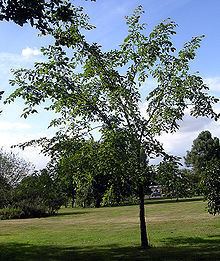Scientific name Ulmus castaneifolia | Genus Ulmus Rank Species | |
 | ||
Similar Ulmus bergmanniana, Ulmus microcarpa, Ulmus changii, Ulmus chenmoui, Ulmus szechuanica | ||
Ulmus castaneifolia , the chestnut-leafed elm or multinerved elm, is a small deciduous tree found across much of China in broadleaved forests at elevations of 500–1,600 metres (1,600–5,200 ft).
Contents
Description
The tree can reach a height of 20 metres (66 ft) with a trunk of about 0.5 m d.b.h. The bark is thick with a pronounced corky layer, and is longitudinally fissured. The branchlets are devoid of the corky wings common to many elms. The leaves are generally narrow, ranging from obovate to elliptic, up to 15 cm long, and densely hirsute when young. The perfect wind-pollinated apetalous flowers are produced on second-year shoots in February; the samarae are mostly obovate < 30 × 16 mm.
Pests and diseases
Ulmus castaneifolia is resistant to Dutch elm disease and to elm leaf beetle Xanthogaleruca luteola.
Cultivation
The species is very rare in cultivation; it was one of 12 Chinese species under evaluation at the Morton Arboretum, Illinois, in 2009 by the late Dr George Ware. In artificial freezing tests at the arboretum, the LT50 (temperature at which 50% of tissues die) was found to be −26 °C. There are no known cultivars of this taxon, nor is it known to be in commerce beyond the USA.
Notable trees
A UK TROBI champion grows at the Royal Botanic Gardens Kew; planted in 1973, it measured 13 m high by 33 cm d.b.h. in 2010. Another of similar dimensions grows at Calderstones Park, Merseyside.
